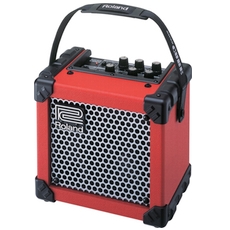 If you want a Fender Deluxe Reverb, Marshall JCM800, and Mesa Rectifier in a lunchbox-sized amp, you can’t beat the Roland Micro Cube.
If you want a Fender Deluxe Reverb, Marshall JCM800, and Mesa Rectifier in a lunchbox-sized amp, you can’t beat the Roland Micro Cube.
While primarily known for their line of keyboards and floor-based effects (in the Boss line), Roland knows a thing or two about guitar amplification. After alll, this is the company that invented amplifier modeling with their COSM technology. Roland’s current crop of guitar amplifiers is known as the Cube series, and one of the most popular models is the Micro Cube, a portable guitar amplifier that runs on either batters or an optional adapter. Why is the Micro Cube so popular? Let’s look at the details and find out.
Specifications
The Micro Cube uses Roland’s heralded COSM technology to model several well-known amplifiers. Available amp models include JC Clean, Black Panel, Brit Combo, Classic Stack, and Rectifier. Acoustic simulation and Microphone settings are also available. There are separate controls for gain, volume, and master tone. Available effects (usable one at a time) include chorus, flanger, phaser, and tremolo. Delay and reverb are also available, though you can only use one at a time.
The Micro Cube runs on Six AA batteries or a Roland Adapter. An onboard “Tuning Fork” is available, as is Headphone/Recording Out and Auxiliary inputs. Finally, the amp is available in a variety of colors (black, white, and red).
Performance
Let me say right off the top that I’m a bit biased. Why? The Roland Micro Cube has been my main practice and teaching studio amplifier for a number of years. I actually have three in my house in different rooms, and I keep two in my teaching studio. Obviously, I’m a fan.
However, the reason why I’m such a fan of the Roland Micro Cube is that, quite simply, I think it’s the best practice amplifier available. The COSM sounds out of this little box are quite convincing. Sure. No one’s going to confuse an amplifier with a 5″ speaker with a real Fender or Marshall, but that’s not the point. I’ve been able to dial in everything from jazz to country to blues to rock in the Micro Cube and it always sounds authentic. With a judicious use of the delay, I can even get some convincing Eric Johnson tones out of this amp.
I’ve even done some acoustic gigs at coffee houses where I used the Micro Cube as the main guitar amp. It has to be a pretty small venue for the Micro Cube to manage the load, but I’ve gigged with it a few times with no problems.
But it excels as a reliable and good sounding practice amplifier. Honestly, I’ve kept the two Micro Cubes in my teaching studio running continuously for two years with no problems whatsoever. My only wish is that Roland would offer separate controls for the reverb and delay, but given all they offer in such a small package, it’s hard to complain.
Final Thoughts
Inexpensive amps are a dime a dozen, but it’s hard to find one that matches the quality of the Roland Micro Cube. Even as a practice amplifier, it’s practical for some low-volume gigs. If you want a Fender Deluxe Reverb, Marshall JCM800, and Mesa Rectifier in a lunchbox-sized amp, you can’t beat the Roland Micro Cube.
Name of Gear: Roland Micro Cube
List Price: $154.50
Manufacturer Info: Roland Corporation; roland.com
Pros: Wide range of amp simulations; excellent quality effects; long battery life
Cons: No separate delay and reverb